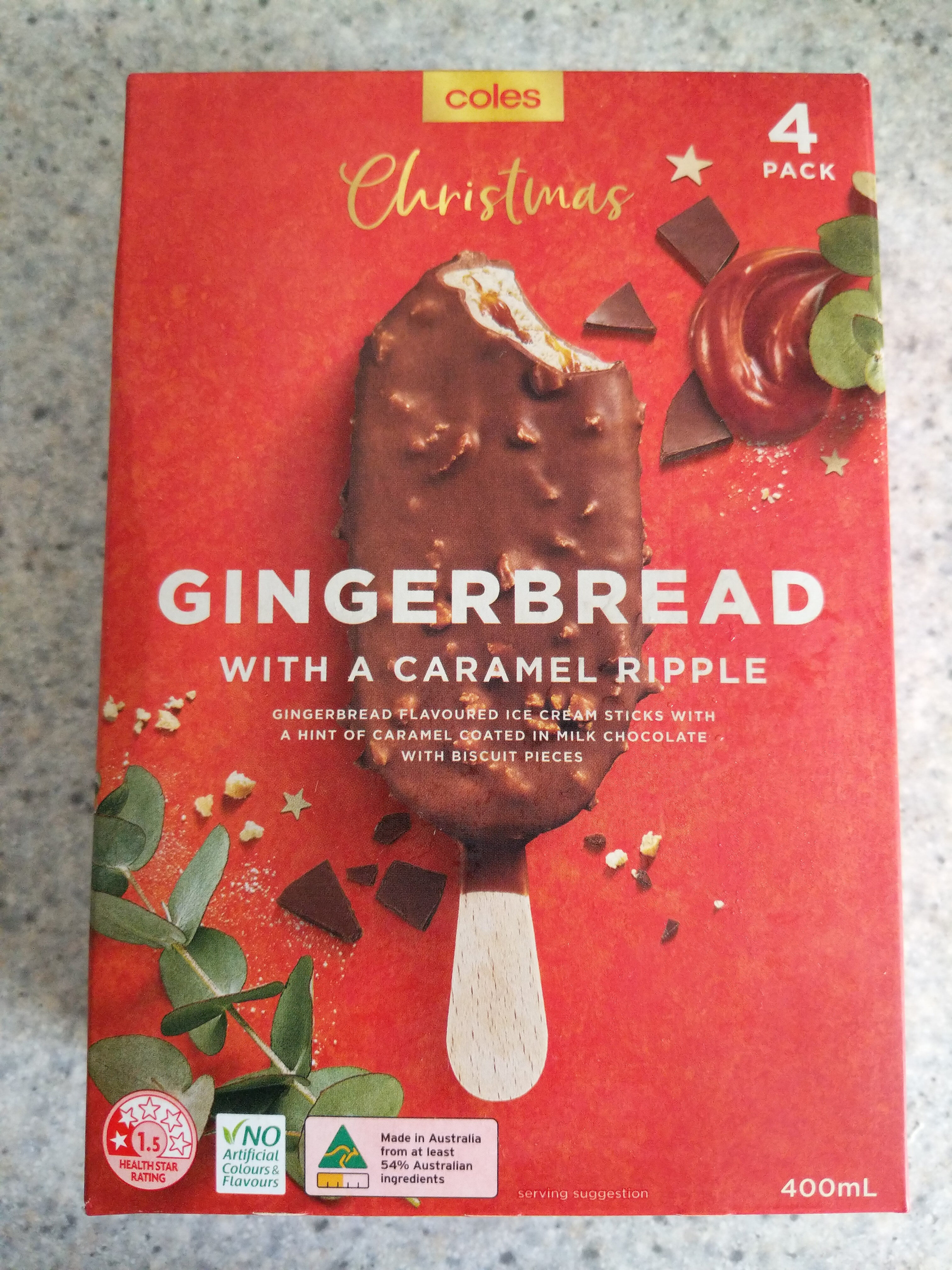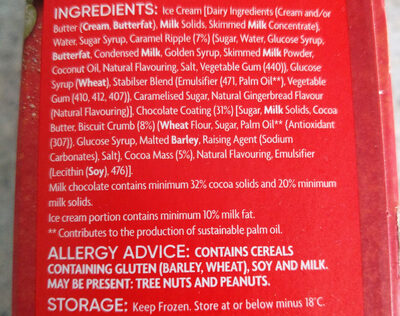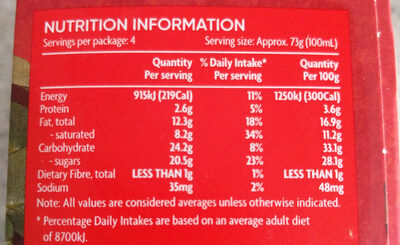Help us make food transparency the norm!
As a non-profit organization, we depend on your donations to continue informing consumers around the world about what they eat.
The food revolution starts with you!
Gingerbread with a Caramel Ripple Ice Cream Sticks - Coles - 400 ml
Gingerbread with a Caramel Ripple Ice Cream Sticks - Coles - 400 ml
This product page is not complete. You can help to complete it by editing it and adding more data from the photos we have, or by taking more photos using the app for Android or iPhone/iPad. Thank you!
×
Barcode: 9310645320229 (EAN / EAN-13)
Quantity: 400 ml
Packaging: Box
Brands: Coles
Categories: Desserts, Frozen foods, Frozen desserts, Ice creams and sorbets, Ice creams
Labels, certifications, awards:
Sustainable, Vegetarian, Sustainable Palm Oil, Australian made, Health Star Rating, Health Star Rating 1.5
Stores: Coles
Countries where sold: Australia
Matching with your preferences
Health
Ingredients
-
66 ingredients
Ice Cream [Dairy Ingredients (Cream and/or Butter (Cream, Butterfat), Milk Solids, Skimmed Milk Concentrate). Water, Sugar Syrup, Caramel Ripple (7%) (Sugar, Water, Glucose Syrup. Butterfat, Condensed Milk, Golden Syrup, Skimmed Milk Powder, Coconut Oil, Natural Flavouring, Salt, Vegetable Gum (440)), Glucose Syrup (Wheat), Stabilser Blend (Emulsifier (471, Palm Oil**), Vegetable Gum (410, 412, 407)), Caramelised Sugar, Natural Gingerbread Flavour (Natural Flavouring)], Chocolate Coating (31%) [Sugar, Milk Solids, Cocoa Butter, Biscuit Crumb (8%) (Wheat Flour, Sugar, Palm Oil** (Antioxidant (307)}, Glucose Syrup, Malted Barley, Raising Agent (Sodium Carbonates), Salt), Cocoa Mass (5%), Natural Flavouring, Emulsifier (Lecithin (Soy), 476)]. Milk chocolate contains minimum 32% cocoa solids and 20% minimum milk solids. Ice cream portion contains minimum 10% milk fat. ** Contributes to the production of sustainable palm oil. ALLERGY ADVICE: CONTAINS CEREALS CONTAINING GLUTEN (BARLEY, WHEAT), SOY AND MILK. MAY BE PRESENT: TREE NUTS AND PEANUTS. STORAGE: Keep Frozen. Store at or below minus 18°C.Allergens: Gluten, Milk, SoybeansTraces: Nuts, Peanuts
Food processing
-
Ultra processed foods
Elements that indicate the product is in the 4 - Ultra processed food and drink products group:
- Additive: E322 - Lecithins
- Additive: E407 - Carrageenan
- Additive: E410 - Locust bean gum
- Additive: E412 - Guar gum
- Additive: E471 - Mono- and diglycerides of fatty acids
- Additive: E476 - Polyglycerol polyricinoleate
- Ingredient: Emulsifier
- Ingredient: Flavouring
- Ingredient: Glucose
- Ingredient: Glucose syrup
- Ingredient: Invert sugar
Food products are classified into 4 groups according to their degree of processing:
- Unprocessed or minimally processed foods
- Processed culinary ingredients
- Processed foods
- Ultra processed foods
The determination of the group is based on the category of the product and on the ingredients it contains.
Additives
-
E307 - Alpha-tocopherol
Alpha-Tocopherol: α-Tocopherol is a type of vitamin E. It has E number "E307". Vitamin E exists in eight different forms, four tocopherols and four tocotrienols. All feature a chromane ring, with a hydroxyl group that can donate a hydrogen atom to reduce free radicals and a hydrophobic side chain which allows for penetration into biological membranes. Compared to the others, α-tocopherol is preferentially absorbed and accumulated in humans.Source: Wikipedia
-
E322 - Lecithins
Lecithins are natural compounds commonly used in the food industry as emulsifiers and stabilizers.
Extracted from sources like soybeans and eggs, lecithins consist of phospholipids that enhance the mixing of oil and water, ensuring smooth textures in various products like chocolates, dressings, and baked goods.
They do not present any known health risks.
-
E322i - Lecithin
Lecithins are natural compounds commonly used in the food industry as emulsifiers and stabilizers.
Extracted from sources like soybeans and eggs, lecithins consist of phospholipids that enhance the mixing of oil and water, ensuring smooth textures in various products like chocolates, dressings, and baked goods.
They do not present any known health risks.
-
E407 - Carrageenan
Carrageenan (E407), derived from red seaweed, is widely employed in the food industry as a gelling, thickening, and stabilizing agent, notably in dairy and meat products.
It can exist in various forms, each imparting distinct textural properties to food.
However, its degraded form, often referred to as poligeenan, has raised health concerns due to its potential inflammatory effects and its classification as a possible human carcinogen (Group 2B) by the International Agency for Research on Cancer (IARC).
Nevertheless, food-grade carrageenan has been deemed safe by various regulatory bodies when consumed in amounts typically found in food.
-
E410 - Locust bean gum
Locust bean gum: Locust bean gum -LBG, also known as carob gum, carob bean gum, carobin, E410- is a thickening agent and a gelling agent used in food technology.Source: Wikipedia
-
E412 - Guar gum
Guar gum (E412) is a natural food additive derived from guar beans.
This white, odorless powder is valued for its remarkable thickening and stabilizing properties, making it a common ingredient in various food products, including sauces, dressings, and ice creams.
When used in moderation, guar gum is considered safe for consumption, with no known adverse health effects.
-
E471 - Mono- and diglycerides of fatty acids
Mono- and diglycerides of fatty acids (E471), are food additives commonly used as emulsifiers in various processed foods.
These compounds consist of glycerol molecules linked to one or two fatty acid chains, which help stabilize and blend water and oil-based ingredients. E471 enhances the texture and shelf life of products like margarine, baked goods, and ice cream, ensuring a smooth and consistent texture.
It is generally considered safe for consumption within established regulatory limits.
-
E476 - Polyglycerol polyricinoleate
Polyglycerol polyricinoleate: Polyglycerol polyricinoleate -PGPR-, E476, is an emulsifier made from glycerol and fatty acids -usually from castor bean, but also from soybean oil-. In chocolate, compound chocolate and similar coatings, PGPR is mainly used with another substance like lecithin to reduce viscosity. It is used at low levels -below 0.5%-, and works by decreasing the friction between the solid particles -e.g. cacao, sugar, milk- in molten chocolate, reducing the yield stress so that it flows more easily, approaching the behaviour of a Newtonian fluid. It can also be used as an emulsifier in spreads and in salad dressings, or to improve the texture of baked goods. It is made up of a short chain of glycerol molecules connected by ether bonds, with ricinoleic acid side chains connected by ester bonds. PGPR is a yellowish, viscous liquid, and is strongly lipophilic: it is soluble in fats and oils and insoluble in water and ethanol.Source: Wikipedia
-
E500 - Sodium carbonates
Sodium carbonates (E500) are compounds commonly used in food preparation as leavening agents, helping baked goods rise by releasing carbon dioxide when they interact with acids.
Often found in baking soda, they regulate the pH of food, preventing it from becoming too acidic or too alkaline. In the culinary world, sodium carbonates can also enhance the texture and structure of foods, such as noodles, by modifying the gluten network.
Generally recognized as safe, sodium carbonates are non-toxic when consumed in typical amounts found in food.
Ingredients analysis
-
Palm oil
Ingredients that contain palm oil: Palm oil, Palm oil
-
Non-vegan
Non-vegan ingredients: Cream, Butter, Cream, Butterfat, Milk solids, Skimmed milk, Butterfat, Condensed milk, Skimmed milk powder, Milk solids, MilkSome ingredients could not be recognized.
We need your help!
You can help us recognize more ingredients and better analyze the list of ingredients for this product and others:
- Edit this product page to correct spelling mistakes in the ingredients list, and/or to remove ingredients in other languages and sentences that are not related to the ingredients.
- Add new entries, synonyms or translations to our multilingual lists of ingredients, ingredient processing methods, and labels.
If you would like to help, join the #ingredients channel on our Slack discussion space and/or learn about ingredients analysis on our wiki. Thank you!
-
Vegetarian
No non-vegetarian ingredients detected
Unrecognized ingredients: Ice cream, Dairy-ingredients, Caramel-ripple, Vegetable-gum, 440, Stabilser-blend, 471, Vegetable-gum, 410, 412, 407, Natural-gingerbread-flavour, Biscuit, 307, 476, Milk-chocolate-contains-minimum-32-cocoa-solids-and-20-minimum-milk-solids, Ice-cream-portion-contains-minimum-10-milk-fat, Contributes-to-the-production-of-sustainable-palm-oil, Storage, Keep-frozen, Store-at-and-below-minus-18-cSome ingredients could not be recognized.
We need your help!
You can help us recognize more ingredients and better analyze the list of ingredients for this product and others:
- Edit this product page to correct spelling mistakes in the ingredients list, and/or to remove ingredients in other languages and sentences that are not related to the ingredients.
- Add new entries, synonyms or translations to our multilingual lists of ingredients, ingredient processing methods, and labels.
If you would like to help, join the #ingredients channel on our Slack discussion space and/or learn about ingredients analysis on our wiki. Thank you!
-
Details of the analysis of the ingredients
We need your help!
Some ingredients could not be recognized.
We need your help!
You can help us recognize more ingredients and better analyze the list of ingredients for this product and others:
- Edit this product page to correct spelling mistakes in the ingredients list, and/or to remove ingredients in other languages and sentences that are not related to the ingredients.
- Add new entries, synonyms or translations to our multilingual lists of ingredients, ingredient processing methods, and labels.
If you would like to help, join the #ingredients channel on our Slack discussion space and/or learn about ingredients analysis on our wiki. Thank you!
: Ice Cream (Dairy Ingredients (Cream, Butter (Cream, Butterfat), Milk Solids, Skimmed Milk), Water, Sugar Syrup, Caramel Ripple 7% (Sugar, Water, Glucose Syrup, Butterfat, Condensed Milk, Golden Syrup, Skimmed Milk Powder, Coconut Oil, Natural Flavouring, Salt, Vegetable Gum (440)), Glucose Syrup (Wheat), Stabilser Blend (Emulsifier (471, Palm Oil), Vegetable Gum (410, 412, 407)), Caramelised Sugar, Natural Gingerbread Flavour (Natural Flavouring)), Chocolate Coating 31% (Sugar, Milk Solids, Cocoa Butter, Biscuit 8%, Wheat Flour, Sugar, Palm Oil (Antioxidant (307), Glucose Syrup, Malted Barley, Raising Agent (Sodium Carbonates), Salt), Cocoa Mass 5%, Natural Flavouring, Emulsifier (Lecithin, 476)), Milk chocolate contains minimum 32% cocoa solids and 20% minimum milk solids, Ice cream portion contains minimum 10% milk fat, Contributes to the production of sustainable palm oil (BARLEY, WHEAT), SOY, MILK, STORAGE (Keep Frozen, Store at and below minus 18°C)- Ice Cream -> en:ice-cream
- Dairy Ingredients -> en:dairy-ingredients
- Cream -> en:cream - vegan: no - vegetarian: yes - ciqual_food_code: 19402
- Butter -> en:butter - vegan: no - vegetarian: yes - ciqual_proxy_food_code: 16400
- Cream -> en:cream - vegan: no - vegetarian: yes - ciqual_food_code: 19402
- Butterfat -> en:butterfat - vegan: no - vegetarian: yes - from_palm_oil: maybe - ciqual_food_code: 16401
- Milk Solids -> en:milk-solids - vegan: no - vegetarian: yes - ciqual_proxy_food_code: 19051
- Skimmed Milk -> en:skimmed-milk - vegan: no - vegetarian: yes - ciqual_proxy_food_code: 19051
- Water -> en:water - vegan: yes - vegetarian: yes - ciqual_food_code: 18066
- Sugar Syrup -> en:sugar-syrup - vegan: yes - vegetarian: yes
- Caramel Ripple -> en:caramel-ripple - percent: 7
- Sugar -> en:sugar - vegan: yes - vegetarian: yes - ciqual_proxy_food_code: 31016
- Water -> en:water - vegan: yes - vegetarian: yes - ciqual_food_code: 18066
- Glucose Syrup -> en:glucose-syrup - vegan: yes - vegetarian: yes - ciqual_proxy_food_code: 31016
- Butterfat -> en:butterfat - vegan: no - vegetarian: yes - from_palm_oil: maybe - ciqual_food_code: 16401
- Condensed Milk -> en:condensed-milk - vegan: no - vegetarian: yes - ciqual_proxy_food_code: 19051
- Golden Syrup -> en:golden-syrup - vegan: yes - vegetarian: yes
- Skimmed Milk Powder -> en:skimmed-milk-powder - vegan: no - vegetarian: yes - ciqual_food_code: 19054
- Coconut Oil -> en:coconut-oil - vegan: yes - vegetarian: yes - from_palm_oil: no - ciqual_food_code: 16040
- Natural Flavouring -> en:natural-flavouring - vegan: maybe - vegetarian: maybe
- Salt -> en:salt - vegan: yes - vegetarian: yes - ciqual_food_code: 11058
- Vegetable Gum -> en:vegetable-gum
- 440 -> en:440
- Glucose Syrup -> en:glucose-syrup - vegan: yes - vegetarian: yes - ciqual_proxy_food_code: 31016
- Wheat -> en:wheat - vegan: yes - vegetarian: yes - ciqual_proxy_food_code: 9410
- Stabilser Blend -> en:stabilser-blend
- Emulsifier -> en:emulsifier
- 471 -> en:471
- Palm Oil -> en:palm-oil - vegan: yes - vegetarian: yes - from_palm_oil: yes - ciqual_food_code: 16129
- Vegetable Gum -> en:vegetable-gum
- 410 -> en:410
- 412 -> en:412
- 407 -> en:407
- Emulsifier -> en:emulsifier
- Caramelised Sugar -> en:caramelised-sugar - vegan: yes - vegetarian: yes - ciqual_proxy_food_code: 31016
- Natural Gingerbread Flavour -> en:natural-gingerbread-flavour
- Natural Flavouring -> en:natural-flavouring - vegan: maybe - vegetarian: maybe
- Dairy Ingredients -> en:dairy-ingredients
- Chocolate Coating -> en:chocolate-coating - vegan: maybe - vegetarian: maybe - percent: 31
- Sugar -> en:sugar - vegan: yes - vegetarian: yes - ciqual_proxy_food_code: 31016
- Milk Solids -> en:milk-solids - vegan: no - vegetarian: yes - ciqual_proxy_food_code: 19051
- Cocoa Butter -> en:cocoa-butter - vegan: yes - vegetarian: yes - ciqual_food_code: 16030
- Biscuit -> en:biscuit - ciqual_food_code: 24000 - percent: 8
- Wheat Flour -> en:wheat-flour - vegan: yes - vegetarian: yes - ciqual_proxy_food_code: 9410
- Sugar -> en:sugar - vegan: yes - vegetarian: yes - ciqual_proxy_food_code: 31016
- Palm Oil -> en:palm-oil - vegan: yes - vegetarian: yes - from_palm_oil: yes - ciqual_food_code: 16129
- Antioxidant -> en:antioxidant
- 307 -> en:307
- Glucose Syrup -> en:glucose-syrup - vegan: yes - vegetarian: yes - ciqual_proxy_food_code: 31016
- Malted Barley -> en:malted-barley - vegan: yes - vegetarian: yes
- Raising Agent -> en:raising-agent
- Sodium Carbonates -> en:e500 - vegan: yes - vegetarian: yes
- Salt -> en:salt - vegan: yes - vegetarian: yes - ciqual_food_code: 11058
- Antioxidant -> en:antioxidant
- Cocoa Mass -> en:cocoa-paste - vegan: yes - vegetarian: yes - ciqual_proxy_food_code: 16030 - percent: 5
- Natural Flavouring -> en:natural-flavouring - vegan: maybe - vegetarian: maybe
- Emulsifier -> en:emulsifier
- Lecithin -> en:e322i - vegan: maybe - vegetarian: maybe
- 476 -> en:476
- Milk chocolate contains minimum 32% cocoa solids and 20% minimum milk solids -> en:milk-chocolate-contains-minimum-32-cocoa-solids-and-20-minimum-milk-solids
- Ice cream portion contains minimum 10% milk fat -> en:ice-cream-portion-contains-minimum-10-milk-fat
- Contributes to the production of sustainable palm oil -> en:contributes-to-the-production-of-sustainable-palm-oil
- BARLEY -> en:barley - vegan: yes - vegetarian: yes
- WHEAT -> en:wheat - vegan: yes - vegetarian: yes - ciqual_proxy_food_code: 9410
- SOY -> en:soya - vegan: yes - vegetarian: yes
- MILK -> en:milk - vegan: no - vegetarian: yes - ciqual_proxy_food_code: 19051
- STORAGE -> en:storage
- Keep Frozen -> en:keep-frozen
- Store at and below minus 18°C -> en:store-at-and-below-minus-18-c
Nutrition
-
Poor nutritional quality
⚠ ️Warning: the amount of fruits, vegetables and nuts is not specified on the label, it was estimated from the list of ingredients: 0This product is not considered a beverage for the calculation of the Nutri-Score.
Positive points: 1
- Proteins: 2 / 5 (value: 3.6, rounded value: 3.6)
- Fiber: 1 / 5 (value: 1, rounded value: 1)
- Fruits, vegetables, nuts, and colza/walnut/olive oils: 0 / 5 (value: 0, rounded value: 0)
Negative points: 19
- Energy: 3 / 10 (value: 1250, rounded value: 1250)
- Sugars: 6 / 10 (value: 28.1, rounded value: 28.1)
- Saturated fat: 10 / 10 (value: 11.2, rounded value: 11.2)
- Sodium: 0 / 10 (value: 48.768, rounded value: 48.8)
The points for proteins are not counted because the negative points are greater or equal to 11.
Nutritional score: (19 - 1)
Nutri-Score:
-
Nutrient levels
-
Fat in moderate quantity (16.9%)
What you need to know- A high consumption of fat, especially saturated fats, can raise cholesterol, which increases the risk of heart diseases.
Recommendation: Limit the consumption of fat and saturated fat- Choose products with lower fat and saturated fat content.
-
Saturated fat in high quantity (11.2%)
What you need to know- A high consumption of fat, especially saturated fats, can raise cholesterol, which increases the risk of heart diseases.
Recommendation: Limit the consumption of fat and saturated fat- Choose products with lower fat and saturated fat content.
-
Sugars in high quantity (28.1%)
What you need to know- A high consumption of sugar can cause weight gain and tooth decay. It also augments the risk of type 2 diabetes and cardio-vascular diseases.
Recommendation: Limit the consumption of sugar and sugary drinks- Sugary drinks (such as sodas, fruit beverages, and fruit juices and nectars) should be limited as much as possible (no more than 1 glass a day).
- Choose products with lower sugar content and reduce the consumption of products with added sugars.
-
Salt in low quantity (0.122%)
What you need to know- A high consumption of salt (or sodium) can cause raised blood pressure, which can increase the risk of heart disease and stroke.
- Many people who have high blood pressure do not know it, as there are often no symptoms.
- Most people consume too much salt (on average 9 to 12 grams per day), around twice the recommended maximum level of intake.
Recommendation: Limit the consumption of salt and salted food- Reduce the quantity of salt used when cooking, and don't salt again at the table.
- Limit the consumption of salty snacks and choose products with lower salt content.
-
-
Nutrition facts
Nutrition facts As sold
for 100 g / 100 mlAs sold
per serving (100ml)Compared to: Ice creams Energy 1,250 kj
(300 kcal)1,250 kj
(300 kcal)+31% Fat 16.9 g 16.9 g +48% Saturated fat 11.2 g 11.2 g +48% Carbohydrates 33.1 g 33.1 g +23% Sugars 28.1 g 28.1 g +34% Fiber < 1 g < 1 g -34% Proteins 3.6 g 3.6 g +8% Salt 0.122 g 0.122 g -43% Fruits‚ vegetables‚ nuts and rapeseed‚ walnut and olive oils (estimate from ingredients list analysis) 0 % 0 %
Environment
-
Eco-Score B - Low environmental impact
⚠ ️The full impact of transportation to your country is currently unknown.The Eco-Score is an experimental score that summarizes the environmental impacts of food products.→ The Eco-Score was initially developped for France and it is being extended to other European countries. The Eco-Score formula is subject to change as it is regularly improved to make it more precise and better suited to each country.Life cycle analysis
-
Average impact of products of the same category: A (Score: 87/100)
Category: Ice cream, cone (normal size)
Category: Ice cream, cone (normal size)
- PEF environmental score: 0.22 (the lower the score, the lower the impact)
- including impact on climate change: 1.75 kg CO2 eq/kg of product
Stage Impact Agriculture
56.9 %Processing
18.1 %Packaging
6.7 %Transportation
6.9 %Distribution
7.2 %Consumption
4.2 %
Bonuses and maluses
-
Missing origins of ingredients information
Malus:
⚠ ️ The origins of the ingredients of this product are not indicated.
If they are indicated on the packaging, you can modify the product sheet and add them.
If you are the manufacturer of this product, you can send us the information with our free platform for producers.
-
Ingredients that threatens species
Malus: -10
Contains palm oil
Tropical forests in Asia, Africa and Latin America are destroyed to create and expand oil palm tree plantations. The deforestation contributes to climate change, and it endangers species such as the orangutan, the pigmy elephant and the Sumatran rhino.
-
Packaging with a medium impact
Malus: -10
Shape Material Recycling Impact Box Unknown High ⚠ ️ The information about the packaging of this product is not sufficiently precise (exact shapes and materials of all components of the packaging).⚠ ️ For a more precise calculation of the Eco-Score, you can modify the product page and add them.
If you are the manufacturer of this product, you can send us the information with our free platform for producers.
Eco-Score for this product
-
Impact for this product: B (Score: 62/100)
Product: Gingerbread with a Caramel Ripple Ice Cream Sticks - Coles - 400 ml
Life cycle analysis score: 87
Sum of bonuses and maluses: -20
Final score: 62/100
-
Carbon footprint
-
Equal to driving 0.9 km in a petrol car
175 g CO² per 100g of product
The carbon emission figure comes from ADEME's Agribalyse database, for the category: Ice cream, cone (normal size) (Source: ADEME Agribalyse Database)
Stage Impact Agriculture
61.0 %Processing
12.3 %Packaging
10.3 %Transportation
11.3 %Distribution
3.7 %Consumption
1.4 %
Packaging
-
Packaging with a medium impact
-
Packaging parts
Box
-
Packaging materials
Material % Packaging weight Packaging weight per 100 g of product
-
Transportation
-
Origins of ingredients
Missing origins of ingredients information
⚠ ️ The origins of the ingredients of this product are not indicated.
If they are indicated on the packaging, you can modify the product sheet and add them.
If you are the manufacturer of this product, you can send us the information with our free platform for producers.Add the origins of ingredients for this product Add the origins of ingredients for this product
Threatened species
-
Contains palm oil
Drives deforestation and threatens species such as the orangutan
Tropical forests in Asia, Africa and Latin America are destroyed to create and expand oil palm tree plantations. The deforestation contributes to climate change, and it endangers species such as the orangutan, the pigmy elephant and the Sumatran rhino.
Report a problem
-
Incomplete or incorrect information?
Category, labels, ingredients, allergens, nutritional information, photos etc.
If the information does not match the information on the packaging, please complete or correct it. Open Food Facts is a collaborative database, and every contribution is useful for all.
Data sources
Product added on by trolley
Last edit of product page on by charlesnepote.
Product page also edited by ecoscore-impact-estimator, openfoodfacts-contributors, packbot, roboto-app, tbound2.











